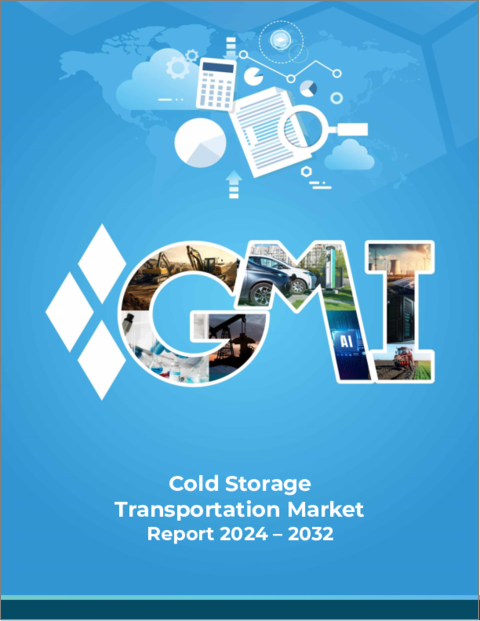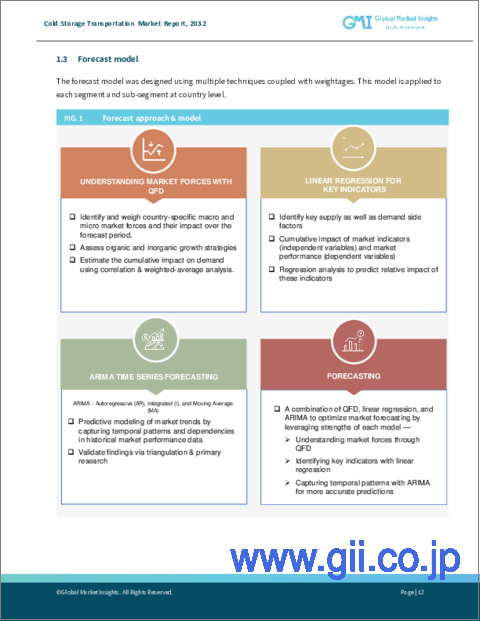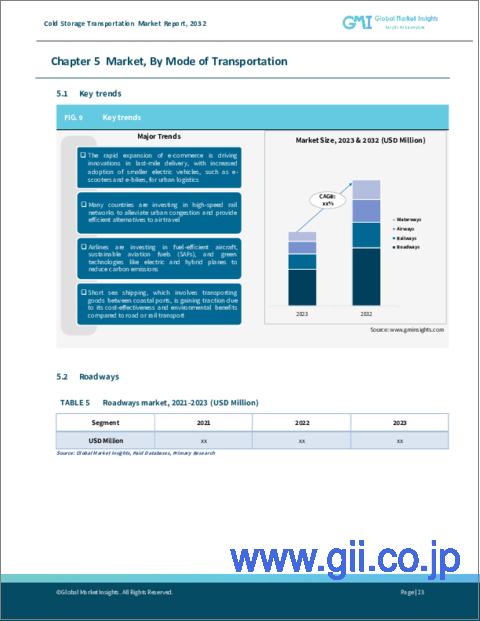|
|
市場調査レポート
商品コード
1570900
冷蔵輸送市場、市場機会、成長促進要因、産業動向分析と予測、2024年~2032年Cold Storage Transportation Market, Opportunity, Growth Drivers, Industry Trend Analysis and Forecast, 2024-2032 |
||||||
カスタマイズ可能
|
|||||||
| 冷蔵輸送市場、市場機会、成長促進要因、産業動向分析と予測、2024年~2032年 |
|
出版日: 2024年08月07日
発行: Global Market Insights Inc.
ページ情報: 英文 220 Pages
納期: 2~3営業日
|
全表示
- 概要
- 目次
2023年に1,260億米ドルと評価された世界の冷蔵輸送市場は、2024年から2032年にかけて5%のCAGRで成長します。
生鮮食品、乳製品、医薬品などの生鮮品の消費の高まりが市場成長を大きく後押しします。エネルギー効率の高い冷却システム、IoTに対応した温度モニタリング、自動化された気候制御など、冷蔵の技術的進歩が冷蔵輸送の効率と信頼性を高めています。これらの技術革新は、最適な温度条件の維持、腐敗の低減、厳格な食品安全規制への準拠の確保に役立ち、市場拡大に拍車をかけています。
冷蔵輸送業界は、輸送手段、温度タイプ、技術、エンドユーザー、用途、地域によって区分されます。
空気吹き込み式蒸発器分野は、正確な温度制御を維持する効率性と有効性が評価され、2024年から2032年にかけてCAGR 5%を獲得する見込みです。これらのシステムは、生鮮品の冷蔵ニーズを管理し、輸送中の最適条件を確保するために極めて重要です。安定した冷却を提供する能力と、さまざまな保管要件への適応性により、好んで選ばれています。さらに、エネルギー効率や信頼性の向上など、エアブロー蒸発器技術の進歩が、冷蔵輸送市場での優位性をさらに高めています。
食品・飲料分野は、生鮮品の最適な温度条件を維持する必要性が高いため、2032年までに評価額が500億米ドルを超えると予想されます。生鮮食品、乳製品、冷凍食品に対する需要の増加が、効率的な保冷ソリューションの必要性を高めています。高度な冷凍技術と厳格な食品安全規制は、信頼性の高い冷蔵輸送の重要性をさらに強調しています。消費者の嗜好が新鮮で高品質な製品にシフトしているため、飲食品分野は今後も市場を独占し続けると思われます。
北米の保冷輸送業界は2023年に35%のシェアを獲得したが、これは高度なインフラ、生鮮品の高い消費量、厳格な食品安全規制が拍車をかけています。同地域の確立された物流ネットワークと冷凍システムの技術的進歩は、効率的な低温貯蔵と輸送を支えています。生鮮食品と冷凍食品に対する需要の増加は、コールドチェーン・ソリューションへの十分な投資と相まって、市場の成長をさらに後押ししています。北米の強固な市場プレゼンスと継続的な技術革新は、北米を低温貯蔵輸送市場の重要な貢献国にしています。
目次
第1章 調査手法と調査範囲
第2章 エグゼクティブサマリー
第3章 業界洞察
- エコシステム分析
- ベンダー・マトリックス
- 利益率分析
- テクノロジーとイノベーションの展望
- 特許分析
- 主要ニュースと取り組み
- 規制状況
- 影響要因
- 促進要因
- 利便性と賞味期限の延長による冷凍食品需要の増加
- 冷凍技術の進歩による効率と信頼性の向上
- 高度な冷蔵ソリューションを必要とするeコマースと国際貿易の拡大
- 厳格な食品安全規制により、堅牢な冷蔵倉庫の必要性が高まる
- エネルギー効率の高い冷却や環境に優しい冷媒など、持続可能性への注目の高まり
- 業界の潜在的リスク&課題
- 高度な冷蔵システムと施設メンテナンスに関連する高い運用コスト
- 各地域で進化する食品安全規制への複雑な規制対応
- 促進要因
- 成長可能性分析
- ポーター分析
- PESTEL分析
第4章 競合情勢
- イントロダクション
- 企業シェア分析
- 競合のポジショニング・マトリックス
- 戦略展望マトリックス
第5章 市場推計・予測:輸送手段別、2021年~2032年
- 主要動向
- 道路
- 鉄道
- 航空
- 水路
第6章 市場推計・予測:温度タイプ別、2021年~2032年
- 主要動向
- フローズン
- チルド
第7章 技術別市場推計・予測:技術別、2021年~2032年
- 主要動向
- 蒸気圧縮システム
- エアブローエバポレーター
- 共晶デバイス
第8章 市場推計・予測:エンドユーザー別、2021年~2032年
- 主要動向
- 飲食品
- ヘルスケア
- 医薬品
- 化学品
- 植物と花
- 化粧品
- その他
第9章 市場推計・予測:用途別、2021年~2032年
- 主要動向
- 乳製品
- 牛乳
- チーズ
- バター
- ヨーグルト
- アイスクリーム
- 果物・野菜
- 新鮮な果物
- 新鮮な野菜
- ベリー類
- 葉物野菜
- 柑橘類
- 肉、魚、シーフード
- 牛肉
- 豚肉
- 家禽類
- 魚類
- 貝類
- ベーカリー・菓子類
- 焼き菓子
- チョコレート
- キャンディー
- ペストリー
- 生地
- 医薬品
- ワクチン
- 生物製剤
- インシュリン
- 血液製剤
- 特殊医薬品
- 化学品
- 工業用化学品
- 特殊化学品
- 農業化学品
- 危険物
- 研究用試薬
- 加工食品
- 調理済み食品
- 冷凍食品
- 缶詰
- スナック菓子
- ソース・調味料
- その他
- 化粧品
- 電化製品
- 美術品・骨董品
- 医療機器
- 生鮮品
第10章 市場推計・予測:地域別、2021年~2032年
- 主要動向
- 北米
- 米国
- カナダ
- 欧州
- 英国
- ドイツ
- フランス
- イタリア
- スペイン
- その他欧州
- アジア太平洋
- 中国
- インド
- 日本
- 韓国
- ニュージーランド
- その他アジア太平洋
- ラテンアメリカ
- ブラジル
- メキシコ
- その他ラテンアメリカ
- 中東・アフリカ
- UAE
- 南アフリカ
- サウジアラビア
- その他の中東・アフリカ
第11章 企業プロファイル
- A.B. Oxford Cold Storage
- Agro Merchants Group
- Americold Logistics
- Burris Logistics
- Cloverleaf Cold Storage
- Congebec
- DHL Supply Chain
- Frialsa Frigorificos
- Frigoglass
- Hanson Logistics
- Henningsen Cold Storage Co.
- Interstate Cold Storage, Inc.
- Klinge Corporation
- Kloosterboer
- Lineage Logistics
- NewCold Advanced Cold Logistics
- Nichirei Logistics Group
- Nordic Logistics and Warehousing
- OOCL Logistics
- Swire Cold Storage
- Trenton Cold Storage
- United States Cold Storage, Inc.
- VersaCold Logistics Services
- Wabash National Corporation
- XPO Logistics, Inc.
The Global Cold Storage Transportation Market, valued at USD 126 billion in 2023, will grow at a 5% CAGR from 2024 to 2032. The rising consumption of perishable goods, such as fresh produce, dairy products, and pharmaceuticals, significantly drives market growth. Technological advancements in refrigeration, including energy-efficient cooling systems, IoT-enabled temperature monitoring, and automated climate control, are enhancing the efficiency and reliability of cold storage transportation. These innovations help maintain optimal temperature conditions, reduce spoilage, and ensure compliance with stringent food safety regulations, fueling market expansion.
The cold storage transportation industry is segmented based on mode of transportation, temperature type, technology, end-user, application, and region.
The air-blown evaporators segment will capture 5% CAGR between 2024 and 2032, attributed to their efficiency and effectiveness in maintaining precise temperature control. These systems are crucial for managing the refrigeration needs of perishable goods and ensuring optimal conditions during transportation. Their ability to provide consistent cooling and their adaptability to various storage requirements make them a preferred choice. Additionally, advancements in air-blown evaporator technology, such as improved energy efficiency and reliability, further bolster their dominance in the cold storage transportation market.
The food and beverages segment will reach a valuation of over USD 50 billion by 2032 due to the critical need for maintaining optimal temperature conditions for perishable items. The increasing demand for fresh produce, dairy products, and frozen foods drives the necessity for efficient cold storage solutions. Advanced refrigeration technologies and stringent food safety regulations further emphasize the importance of reliable cold storage transportation. As consumer preferences shift towards fresh and high-quality products, the food and beverages segment will continue to dominate the market.
North America cold storage transportation industry garnered 35% share in 2023, spurred by its advanced infrastructure, high consumption of perishable goods, and stringent food safety regulations. The region's well-established logistics networks and technological advancements in refrigeration systems support efficient cold storage and transportation. The increasing demand for fresh and frozen foods, coupled with ample investments in cold chain solutions, further drives market growth. North America's robust market presence and ongoing innovations make it a vital contributor to the cold storage transportation market.
Table of Contents
Chapter 1 Methodology and Scope
- 1.1 Market scope and definition
- 1.2 Base estimates and calculations
- 1.3 Forecast calculation
- 1.4 Data sources
- 1.4.1 Primary
- 1.4.2 Secondary
- 1.4.2.1 Paid sources
- 1.4.2.2 Public sources
Chapter 2 Executive Summary
- 2.1 Industry 360° synopsis, 2021 - 2032
Chapter 3 Industry Insights
- 3.1 Industry ecosystem analysis
- 3.2 Vendor matrix
- 3.3 Profit margin analysis
- 3.4 Technology and innovation landscape
- 3.5 Patent analysis
- 3.6 Key news and initiatives
- 3.7 Regulatory landscape
- 3.8 Impact forces
- 3.8.1 Growth drivers
- 3.8.1.1 Rising demand for frozen foods due to convenience and extended shelf life
- 3.8.1.2 Advancements in refrigeration technology improving efficiency and reliability
- 3.8.1.3 Expansion of e-commerce and global trade requiring advanced cold storage solutions
- 3.8.1.4 Stringent food safety regulations increasing the need for robust cold storage
- 3.8.1.5 Increased focus on sustainability, including energy-efficient cooling and eco-friendly refrigerants
- 3.8.2 Industry pitfalls and challenges
- 3.8.2.1 High operational costs related to advanced refrigeration systems and facility maintenance
- 3.8.2.2 Complex regulatory compliance with evolving food safety regulations across regions
- 3.8.1 Growth drivers
- 3.9 Growth potential analysis
- 3.10 Porter's analysis
- 3.10.1 Supplier power
- 3.10.2 Buyer power
- 3.10.3 Threat of new entrants
- 3.10.4 Threat of substitutes
- 3.10.5 Industry rivalry
- 3.11 PESTEL analysis
Chapter 4 Competitive Landscape, 2023
- 4.1 Introduction
- 4.2 Company market share analysis
- 4.3 Competitive positioning matrix
- 4.4 Strategic outlook matrix
Chapter 5 Market Estimates and Forecast, By Mode of Transportation, 2021 - 2032 (USD billion)
- 5.1 Key trends
- 5.2 Roadways
- 5.3 Railways
- 5.4 Airways
- 5.5 Waterways
Chapter 6 Market Estimates and Forecast, By Temperature Type, 2021 - 2032 (USD billion)
- 6.1 Key trends
- 6.2 Frozen
- 6.3 Chilled
Chapter 7 Market Estimates and Forecast, By Technology, 2021 - 2032 (USD billion)
- 7.1 Key trends
- 7.2 Vapor compression systems
- 7.3 Air-blown evaporators
- 7.4 Eutectic Devices
Chapter 8 Market Estimates and Forecast, By End-User, 2021 - 2032 (USD billion)
- 8.1 Key trends
- 8.2 Food and beverages
- 8.3 Healthcare
- 8.4 Pharmaceuticals
- 8.5 Chemicals
- 8.6 Plants and flowers
- 8.7 Cosmetics
- 8.8 Others
Chapter 9 Market Estimates and Forecast, By Application, 2021 - 2032 (USD billion)
- 9.1 Key trends
- 9.2 Dairy products
- 9.2.1 Milk
- 9.2.2 Cheese
- 9.2.3 Butter
- 9.2.4 Yogurt
- 9.2.5 Ice cream
- 9.3 Fruits and vegetables
- 9.3.1 Fresh fruits
- 9.3.2 Fresh vegetables
- 9.3.3 Berries
- 9.3.4 Leafy greens
- 9.3.5 Citrus fruits
- 9.4 Meat, fish, and seafood
- 9.4.1 Beef
- 9.4.2 Pork
- 9.4.3 Poultry
- 9.4.4 Fish
- 9.4.5 Shellfish
- 9.5 Bakery and confectionery
- 9.5.1 Baked goods
- 9.5.2 Chocolates
- 9.5.3 Candies
- 9.5.4 Pastries
- 9.5.5 Doughs
- 9.6 Pharmaceuticals
- 9.6.1 Vaccines
- 9.6.2 Biologics
- 9.6.3 Insulin
- 9.6.4 Blood products
- 9.6.5 Specialty drugs
- 9.7 Chemicals
- 9.7.1 Industrial chemicals
- 9.7.2 Specialty chemicals
- 9.7.3 Agricultural chemicals
- 9.7.4 Hazardous materials
- 9.7.5 Laboratory reagents
- 9.8 Processed food
- 9.8.1 Ready-to-Eat meals
- 9.8.2 Frozen foods
- 9.8.3 Canned foods
- 9.8.4 Packaged snacks
- 9.8.5 Sauces and condiments
- 9.9 Others
- 9.9.1 Cosmetics
- 9.9.2 Electronics
- 9.9.3 Art and Antiques
- 9.9.4 Medical devices
- 9.9.5 Perishable goods
Chapter 10 Market Estimates and Forecast, By Region, 2021 - 2032 (USD billion)
- 10.1 Key trends
- 10.2 North America
- 10.2.1 U.S.
- 10.2.2 Canada
- 10.3 Europe
- 10.3.1 UK
- 10.3.2 Germany
- 10.3.3 France
- 10.3.4 Italy
- 10.3.5 Spain
- 10.3.6 Rest of Europe
- 10.4 Asia Pacific
- 10.4.1 China
- 10.4.2 India
- 10.4.3 Japan
- 10.4.4 South Korea
- 10.4.5 ANZ
- 10.4.6 Rest of Asia Pacific
- 10.5 Latin America
- 10.5.1 Brazil
- 10.5.2 Mexico
- 10.5.3 Rest of Latin America
- 10.6 MEA
- 10.6.1 UAE
- 10.6.2 South Africa
- 10.6.3 Saudi Arabia
- 10.6.4 Rest of MEA
Chapter 11 Company Profiles
- 11.1 A.B. Oxford Cold Storage
- 11.2 Agro Merchants Group
- 11.3 Americold Logistics
- 11.4 Burris Logistics
- 11.5 Cloverleaf Cold Storage
- 11.6 Congebec
- 11.7 DHL Supply Chain
- 11.8 Frialsa Frigorificos
- 11.9 Frigoglass
- 11.10 Hanson Logistics
- 11.11 Henningsen Cold Storage Co.
- 11.12 Interstate Cold Storage, Inc.
- 11.13 Klinge Corporation
- 11.14 Kloosterboer
- 11.15 Lineage Logistics
- 11.16 NewCold Advanced Cold Logistics
- 11.17 Nichirei Logistics Group
- 11.18 Nordic Logistics and Warehousing
- 11.19 OOCL Logistics
- 11.20 Swire Cold Storage
- 11.21 Trenton Cold Storage
- 11.22 United States Cold Storage, Inc.
- 11.23 VersaCold Logistics Services
- 11.24 Wabash National Corporation
- 11.25 XPO Logistics, Inc.






